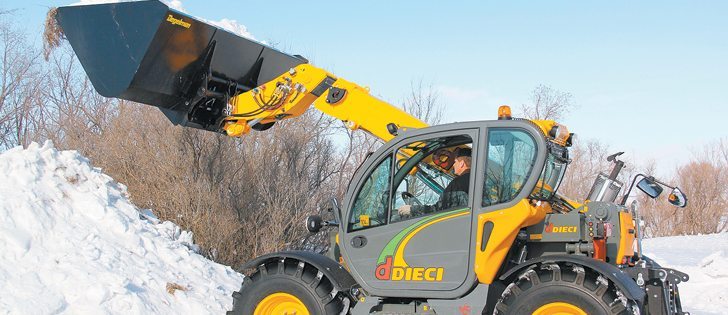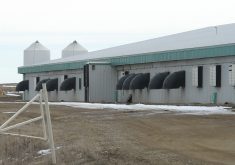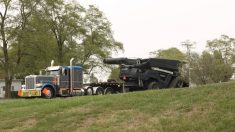Growing popularity | New telehandlers have greater reach, lifting capacity and safety features
BRANDON — Telehandlers, typically found only on dairy operations, are showing up across the Prairies as farmers catch on to their versatility and safety.
Safety is often cited as one of the biggest factors in the growing popularity of telehandlers.
With a lower centre of gravity and the arm pivot anchored to the rear of the machine, heavy loads can be handled with greater accuracy and far less risk than with skid steer loaders, tractors with buckets and payloaders.
“From an attachment perspective, a telehandler has three main advantages compared to other types of loaders,” said Kara Burrell of Agromec Industries in Brandon, which specializes in aftermarket attachments.
Read Also

Phosphate prices to remain high
Phosphate prices are expected to remain elevated, according to Mosaic’s president.
“The telehandler has greater lift capacity, greater reach and better hydraulic flow.”
The versatility extends beyond handling big bales. Telehandlers also work well for handling mini-bulk containers, hay production and as elevated work platforms.
There are specialty attachments for pulling snow off roofs, defacing silage piles, handling manure, shredding bales, snow blades and snow blowers.
The list of attachments is longer in Europe, the home of telehandler technology, where the machines have been used in fieldwork for decades. It’s especially useful in haying operations where the variety of attachments allow the telehandler to perform almost every task.
What’s been missing on the Canadian Prairies until recently is a telehandler with a power take-off and three-point hitch designed specifically for farmers.
However, two such telehandlers are now available to prairie farmers: the Dieci and the Merlo.
Degelman began importing the Dieci AgriPlus 40.7 VS about five years ago. Although it has a decent lift capacity of 9,000 pounds, it does not have a p.t.o. or a three point hitch. The AgriPlus carries a list price of $137,000.
Degelman Dieci representative Sheldon Mohr said the company has sold about 50 AgriPlus units, mostly to dairy operations.
“But we also have customers who bought the AgriPlus mainly for haying and in operations where they’re back grounding cattle. With that long reach, it’s very good for cleaning feedlots.”
Mohr said there was a growing demand for p.t.o. and a three-point hitch. The new AgriTech 35.7 VS is equipped with a 100 horsepower p.t.o. that runs at 1,000 r.p.m. or 540 r.p.m.
There’s also an optional three-point hitch, making it useful for other tasks.
“All the booms come with just one set of hydraulics at the end. We install a splitter valve so there’s dual hydraulics on the front,” said Mohr.
“There’s a secondary pump rated at 30 g.p.m. It doesn’t change the lift capacity, but it gives us faster boom speed and more hydraulic flow.
“We put a snow blower on one last winter. It easily handles one of our buckets or the speed blade, but it won’t work with something really heavy like our 8,000 lb. Pile Driver blade.”
The AgriTech 35.7 VS has a maximum lift capacity of 7,700 lb., maximum height of 23 feet and towing force of 13,220 foot lb.
Standard hydraulic capacity is 24 g.p.m., with an optional 30 g.p.m. pump available. The drive is a Vario hydrostatic system. Power comes from a 128 h.p. Iveco diesel.
“It lists for $168,000, but that price is negotiable,” said Mohr.
Merlo introduced its first agricultural telehandler with p.t.o. and three point hitch in 1999. Today, the Merlo Multifarmer lineup includes six models with engine horsepower from 102 to 156 and p.t.o. h.p. from 80 to 135.
At one time, dairy farms made up the main ag market for telehandlers in Western Canada, but Michael Alexander of Manulift in Alberta said grain farmers now make up the new emerging telehandler market.
“We still sell telehandlers to the smaller dairy producers, but it’s the grain farmers right across all three provinces who are buying telehandlers now,” he said.
Grain farmers typically have a surplus of yard tractors, some with buckets and some that have been retired from the field and now run augers and grain vacs.
Alexander said Multifarmer still fits well on smaller dairy farms that milk 60 to 80 cows and can’t afford to have a dedicated loader tractor but still need something with a three point hitch and p.t.o. to run augers, run the manure agitator, run the grain vac, lift bales and handle silage.
“For the smaller dairy guy, the telehandler replaces a skid steer loader and a loader tractor. It makes good sense. The bigger guy milking 120 to 3,000 cows already has enough fully equipped loader tractors,” he said.
“The small dairy is a shrinking market. In Manitoba, average size is about 123 milking cows. In Saskatchewan, average size is 144 milking cows. In Alberta, it’s 109 milking cows.”
The six Multifarmer models available in Canada have lift capacities from 5,953 to 6,614 lb. Lift height is 20 to 28 feet. The mechanical drive rear p.t.o. has 1,000 and 540 r.p.m.
Prices range from $125,000 for the Multifarmer 27.8 to $150,000 for the 30.9. With a 26 percent market share, Merlo is the largest telehandler company in Canada.
For more information, phone Alexander at 403-461-8107 or visit www.manuflit.ca, or phone Mohr at 306-543-4447 or visit www.degelman.com.
















